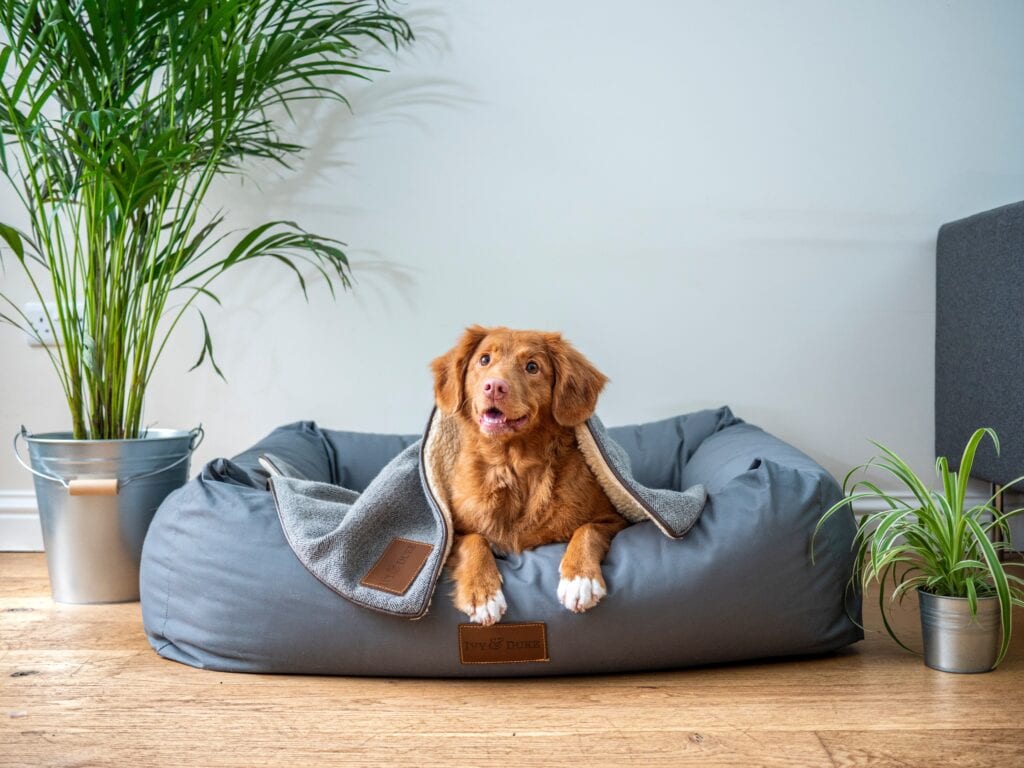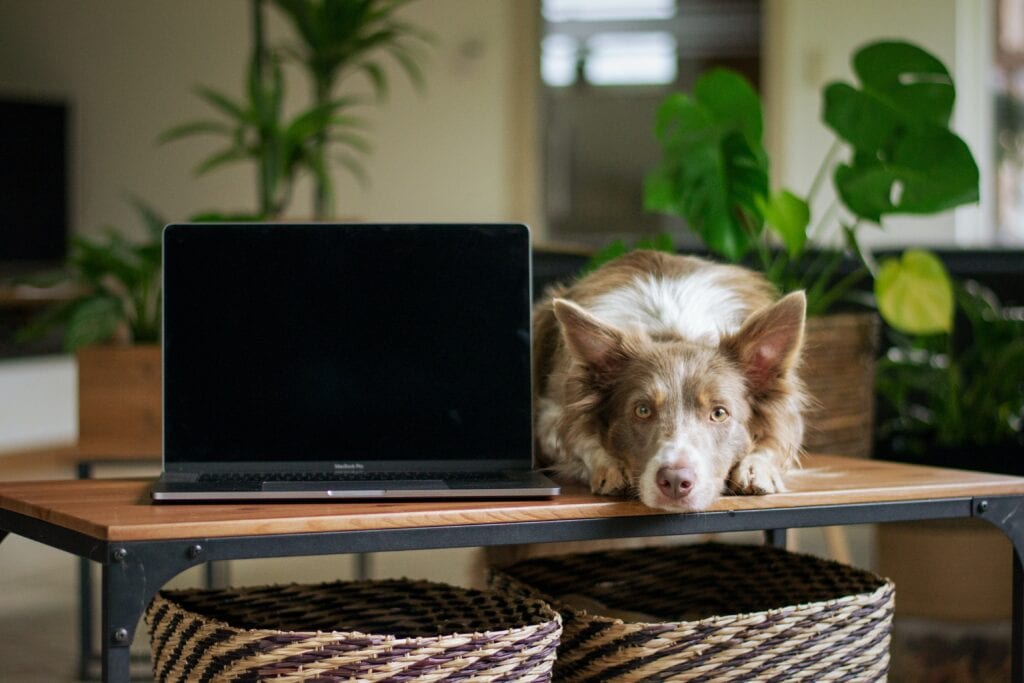We spend so long training our dogs to fit in with our busy working lifestyle, but since the UK went into lockdown, our pooches have got used to a lot more walks, attention and time at home.
As the lockdown restrictions begin to ease and many of us head back to the office, we will have to adjust again to returning to our normal routines – and our pets will too.
As part of their Dog Difference Report, Sean McCormack, Head Vet from dog food company tails.com has put together a guide for dog owners who are worried about the return to work, and how to make the transition back to the office.
Dog Friendly Office – How to Make the Transition Back
Luckily, many companies and workplaces now allow their employees to bring dogs to work, but as the Covid-19 pandemic forced many of us to work from home, our pooches will need to prepare for the daily 9-5 back at the office.
Tips to get you and your pup ready for the 9-5 grind again
- Home Comforts
Just like you might bring an office plant back to the office to replace the one you left behind during the lockdown, personal effects spruce up your workspace and you’ll need to gather a few items that will help your dog feel at home, too.
So, don’t forget their comfy bed so they can zonk out while you work. Gather some of your pooches favourite toys and items that remind them of home. Plus, bring lots of treats to reward their good behaviors, which could be as simple as sitting quietly by your side.
- Train Your Dog to Behave at Work
Your pooch must learn to behave whilst at the office or you could find yourself in trouble. Bad behaviour and habits such as; barking, running wildly through the building and accosting people with unwanted sniffing and, perhaps, jumping will not be tolerated by your company for long.
A key point to remember is that if your dog is returning to the office after a long break away or it is your pups first time at the office they will most likely want to bark, run, and jump when there’s lots to see, smell, and jump on as they’ll be excited to explore the surroundings. The good news is that you can nip these issues in the bud with some simple training. Better yet, these fundamental training skills will strengthen your bond, and your dog will probably enjoy learning a few tricks (especially as a way to score treats).
You can teach your dog to sit and stay which means in the office you can calm your pooch down by giving them commands.
Barking can be a complicated behavior to discourage or correct. Your best bet to reduce barking is to ignore it as much as possible. By engaging with your dog in any way when they bark, you are helping to reinforce the behavior. When it comes to dissuading unwanted behaviors like barking, remember that the goal is to reward the good behavior, not punish the bad. Encourage your dog when they’re behaving the way you like, and ignore them when they’re acting less than professional.
It will be hard to ignore a barking dog at work, so start training and encouraging good behaviour at home and continue this at the office – be consistent with them and they will soon learn not to bark.
- Socialize Your Dog for Work
Remember how nervous you were on your first day of work? Well, your dog will feel exactly the same way on their return to work or first time at the office.
It’s important to take the proper socialization steps so your dog is ready for whatever the office has to throw at them. Ideally, you should socialize your dog as early as possible (if you have a puppy, the first 3–4 months are prime socialization time, after which it can get more difficult). Depending on your dog’s personality, their age, and other factors, the ideal isn’t always possible. That being said, here are a few steps you can take to get your dog ready to handle the office.
- Introduce Your Dog to Coworkers: Take your dog for a quick, leashed walk around the office and introduce them to the people in your area. Offer treats and praise when your dog is behaving well when they meet new people
- Introduce Your Dog to Coworkers’ Dogs: Go for a walk in neutral territory with other dogs from the office and their owners. Walking with other dogs is a great way to make introductions and help new dogs get off on the right paw. Give plenty of treats for both dogs as you make the introduction. Watch out for signs of stress or aggression. If things are going well, just back off for a while.
- Get Your Dog Ready for the Commute: If your dog’s only experience with the car is to either the vet or the groomer, they’ll enjoy the commute to and from work even less than you do. Take them for a few fun trips in the car so they don’t always associate travel with fear or anxiety.
- Potty Training Your Dog for Work
If your dog is returning to the office with you after the lockdown they should have the potty training nailed at work, but accidents can happen. In the weeks leading to you and your pooches return to work make sure you go through potty training at home again before bringing them to the office.
When you are back in the office continue with these best practices:
- ake lots of outdoor bathroom breaks and walks
- Reward your dog when they go outside, where they’re supposed to
- Do not punish them if there’s an accident, as this can make matters worse
- Don’t forget to pack poop bags as well as cleaning supplies… just in case
If your pooch is joining you in the office for the first time, it is important that you nail the potty training at home first, if they are still having accidents at home it is likely to happen in the office.
- How to Tell If Your Dog Is Stressed at Work
Going back to the office or indeed going to the office for the first time could be scary for your pooch and stress them out.
If you see your dog exhibiting stressful behaviors, give them a break from the office by either taking them home, if possible and depending on their stress level; letting them hide out in their crate or bed to calm down; or no longer bringing them to work while you continue socialization and training in a more controlled environment.
Also, consider that many of your colleagues will want to befriend your dog, but simply don’t know when they’re being overbearing, or if your dog just isn’t feeling like making a new friend. Here are some signs that should give your coworkers pause, and potentially make you reconsider your future plans for doggie workdays:
- Ears Pulled Back: There’s a subtlety to reading your dog’s ears. They might pull back their ears when anxious as well as when they’re relaxed. But there are other telltale signs. If your dog’s ears are pulled back tightly against their head, mixed with a tense body posture, they are likely nervous and should not be forced into more intense situations.
- Lip Licking: Is your dog licking their lips/nose like they just gobbled down a meal, even when they haven’t had anything to eat or drink? If so, this is often a sign of stress. Ease up and give them a safe space.
- Scratching: If your dog suddenly starts scratching but you have no reason to believe they’re itchy, it could be another sign they’re stressed.
- Shaking: Full-body shaking — like after your dog comes out of a bath — is one way your dog might try to release stress by literally trying to shake it off.
- Tucked Tail: Your dog’s tail is a fantastic gauge for their mood. Elevated and wagging means all signs are good; tucked firmly between their legs and you’ve got a frightened pooch on your hands. However, don’t always be fooled simply because their tail is wagging. Be mindful of the other signs your dog is displaying, as tail wagging can just as easily be a sign that they’re angry/agitated as happy/excited
- Whale Eyes: Dogs don’t look at people directly in the eyes, but a friendly dog will be more willing to look someone in the face. A wary dog, on the other hand, will often give you “whale eyes,” which you can identify by the position of the head in relation to the eyes. If the dog’s head is pointed one way, while they give someone a sidelong glance, it means they’re keeping an eye on a potential threat, while keeping their body aimed in the direction they’ll go if/when it’s time to skedaddle.
- Barking, Growling, Cowering: While you might recognize the symptoms of a dog that doesn’t want to interact, others might not. Kindly let your coworkers know that a barking or growling dog wants to be left alone and will not be won over.
All credit to tails.com: https://tails.com/
Help keep news FREE for our readers
Supporting your local community newspaper/online news outlet is crucial now more than ever. If you believe in independent journalism, then consider making a valuable contribution by making a one-time or monthly donation. We operate in rural areas where providing unbiased news can be challenging. Read More About Supporting The West Wales Chronicle


























